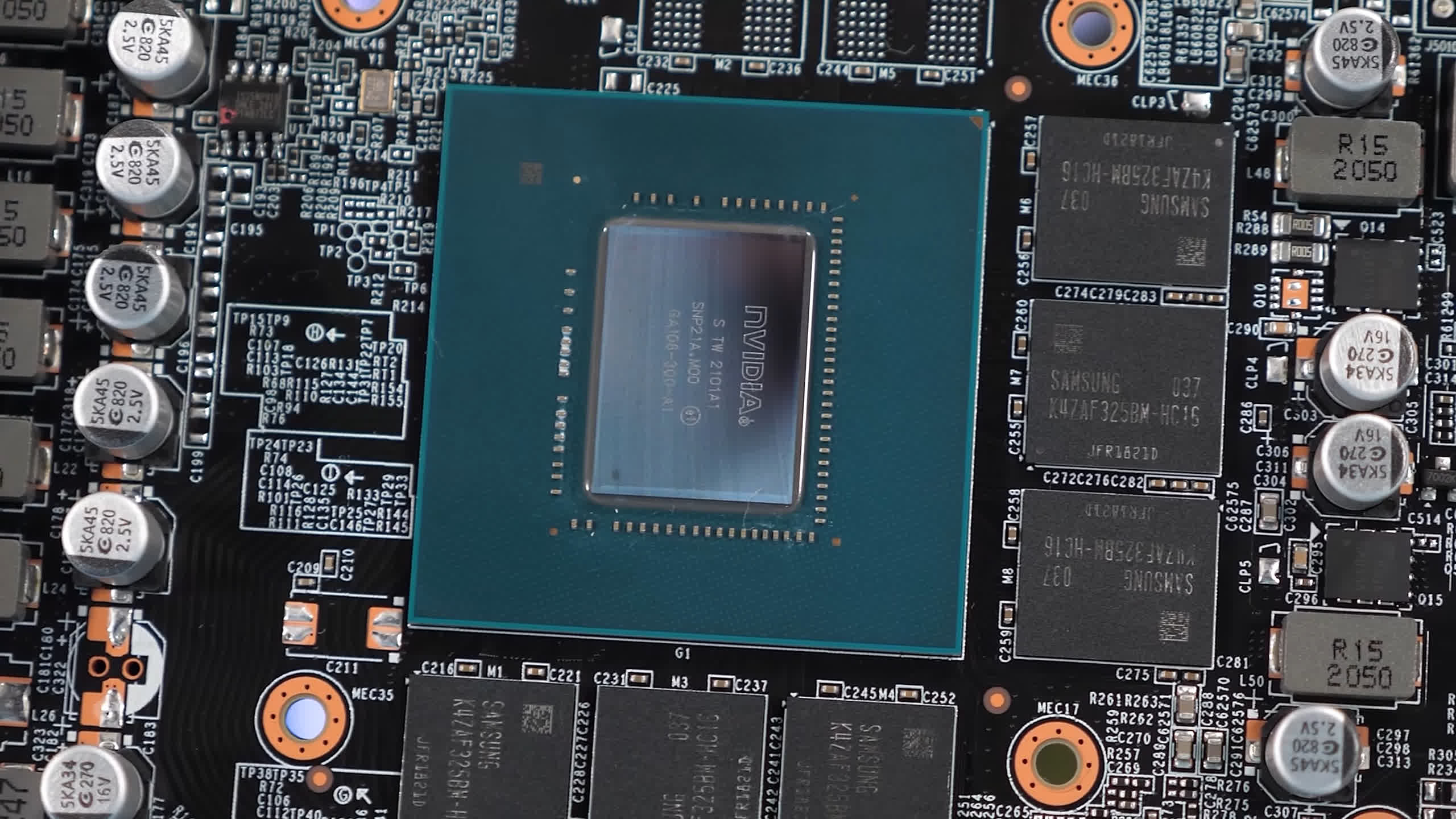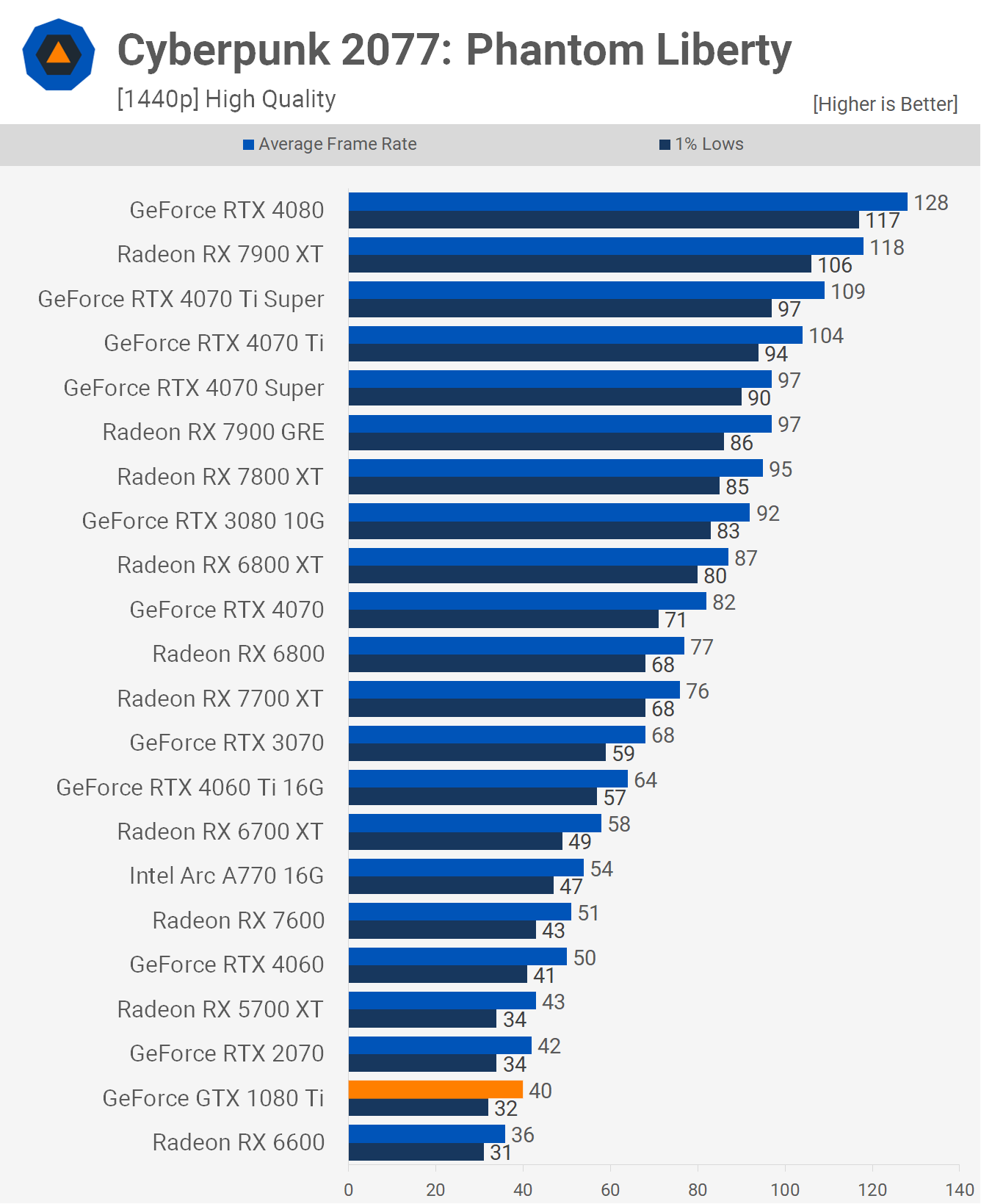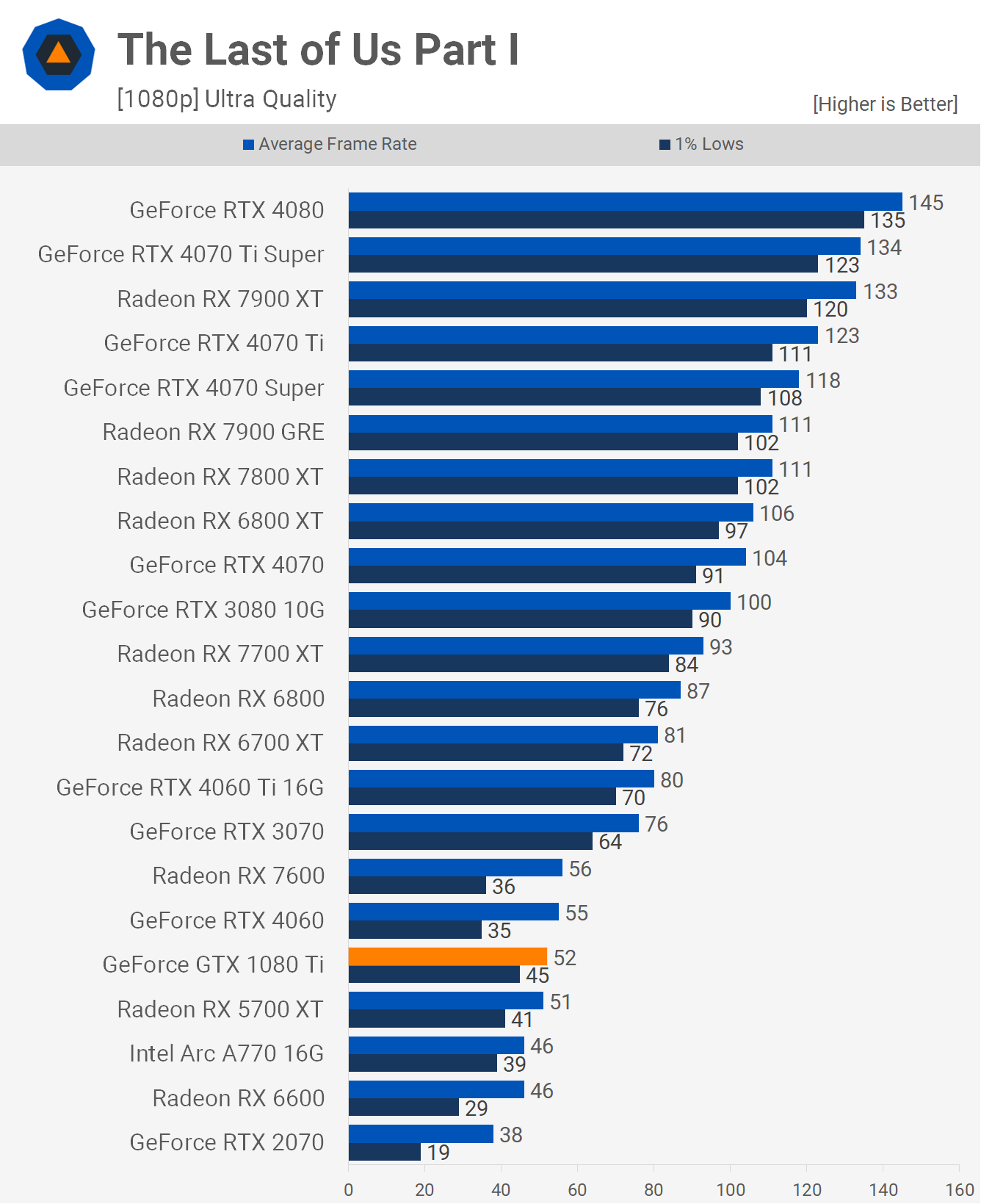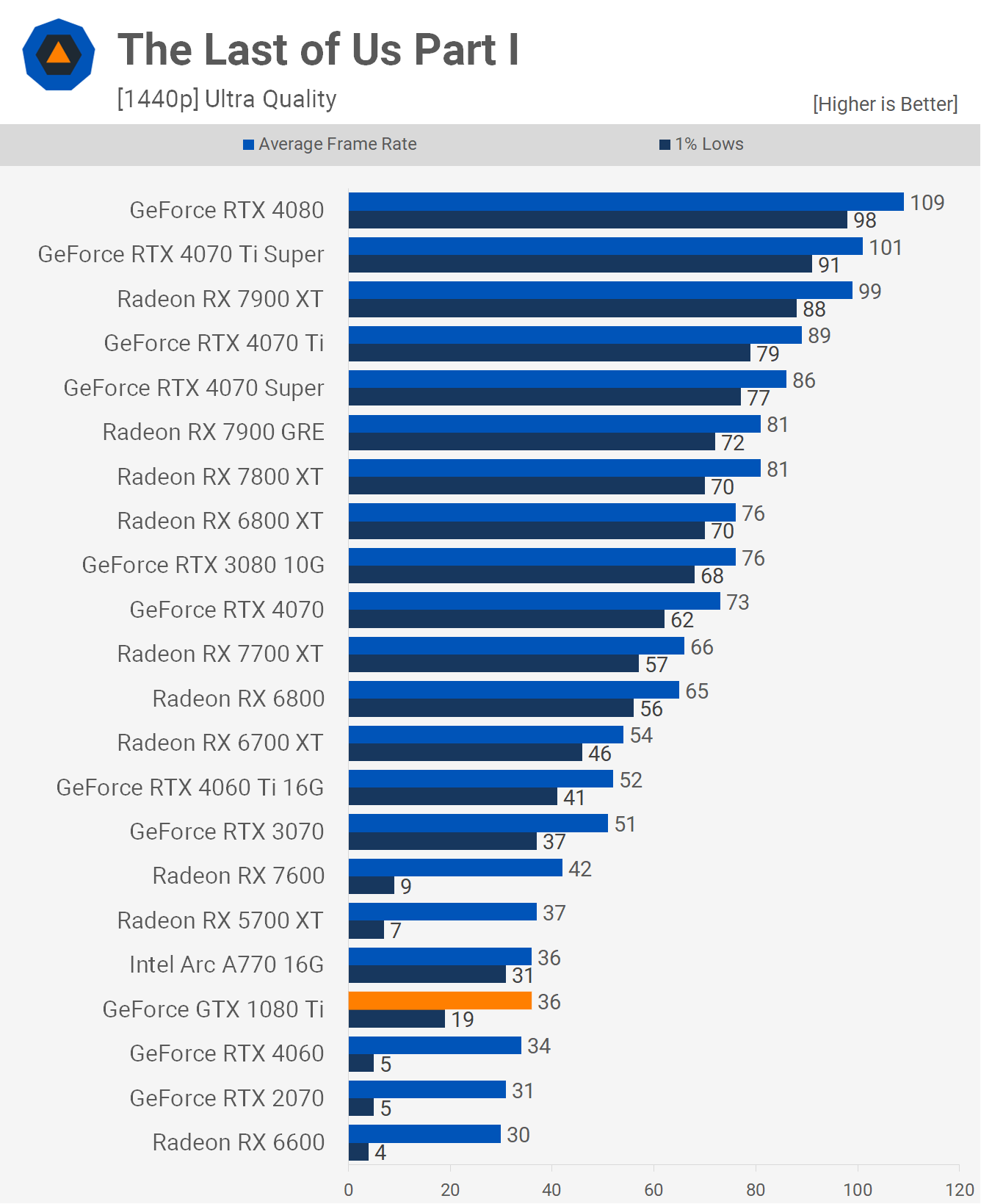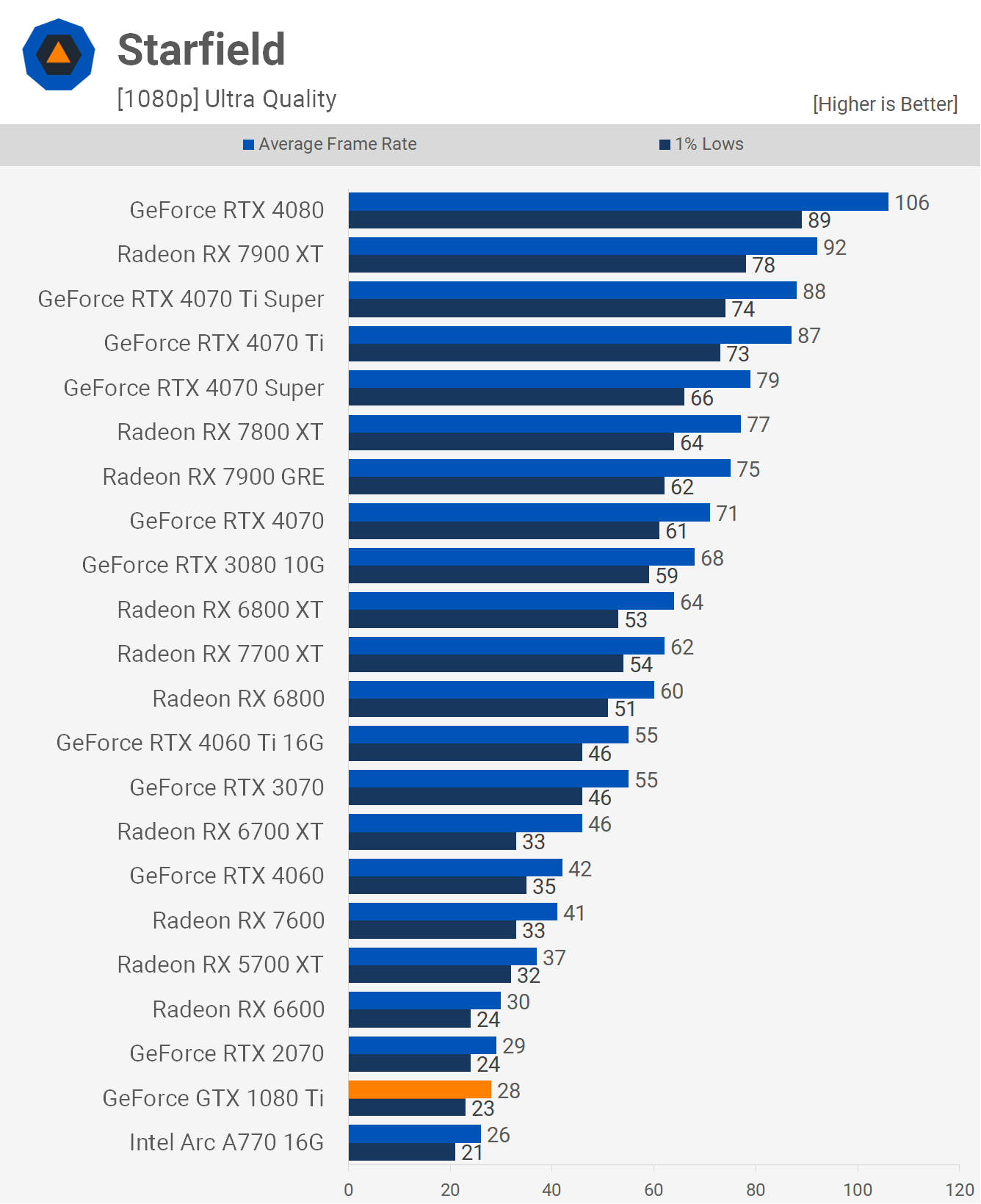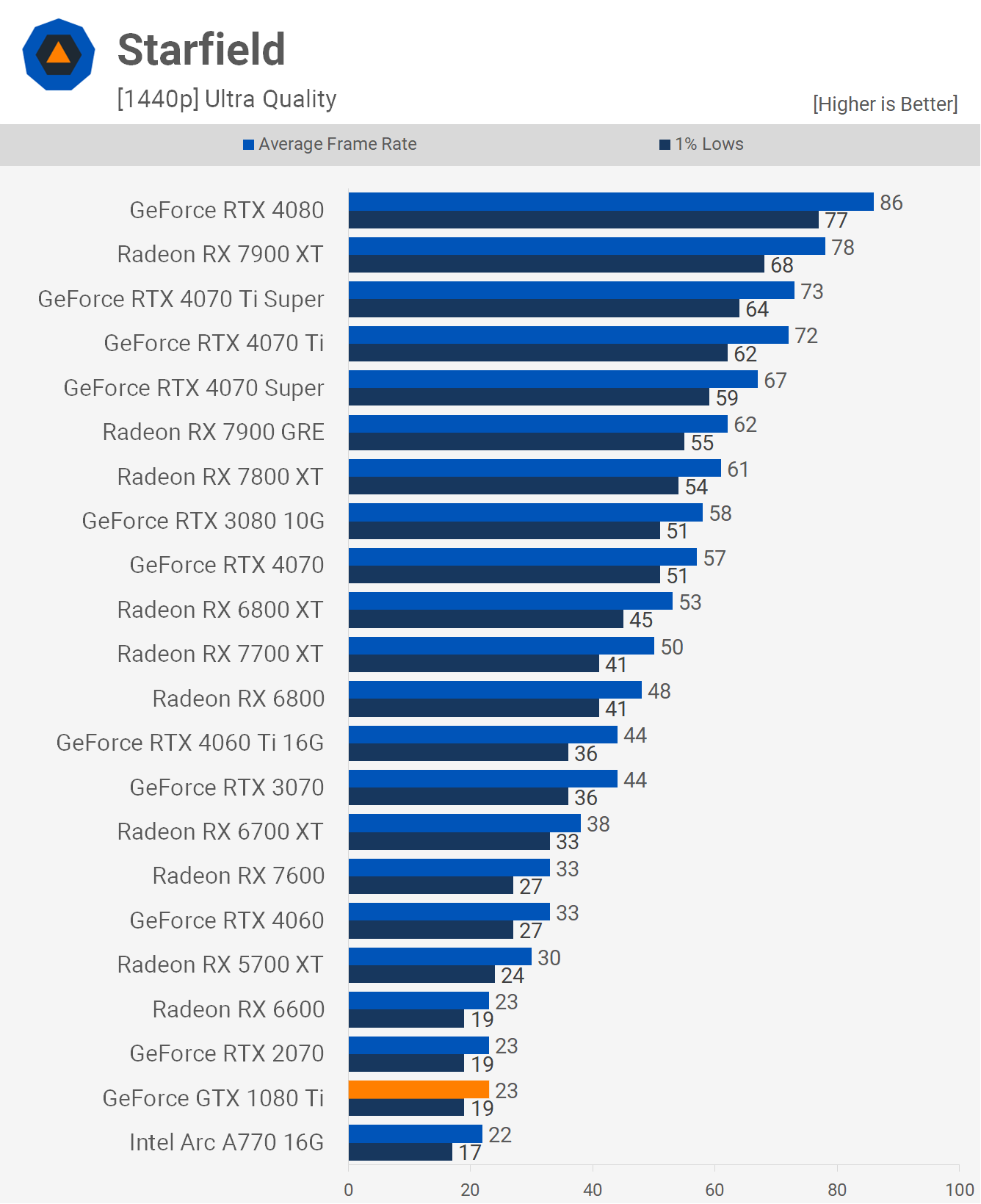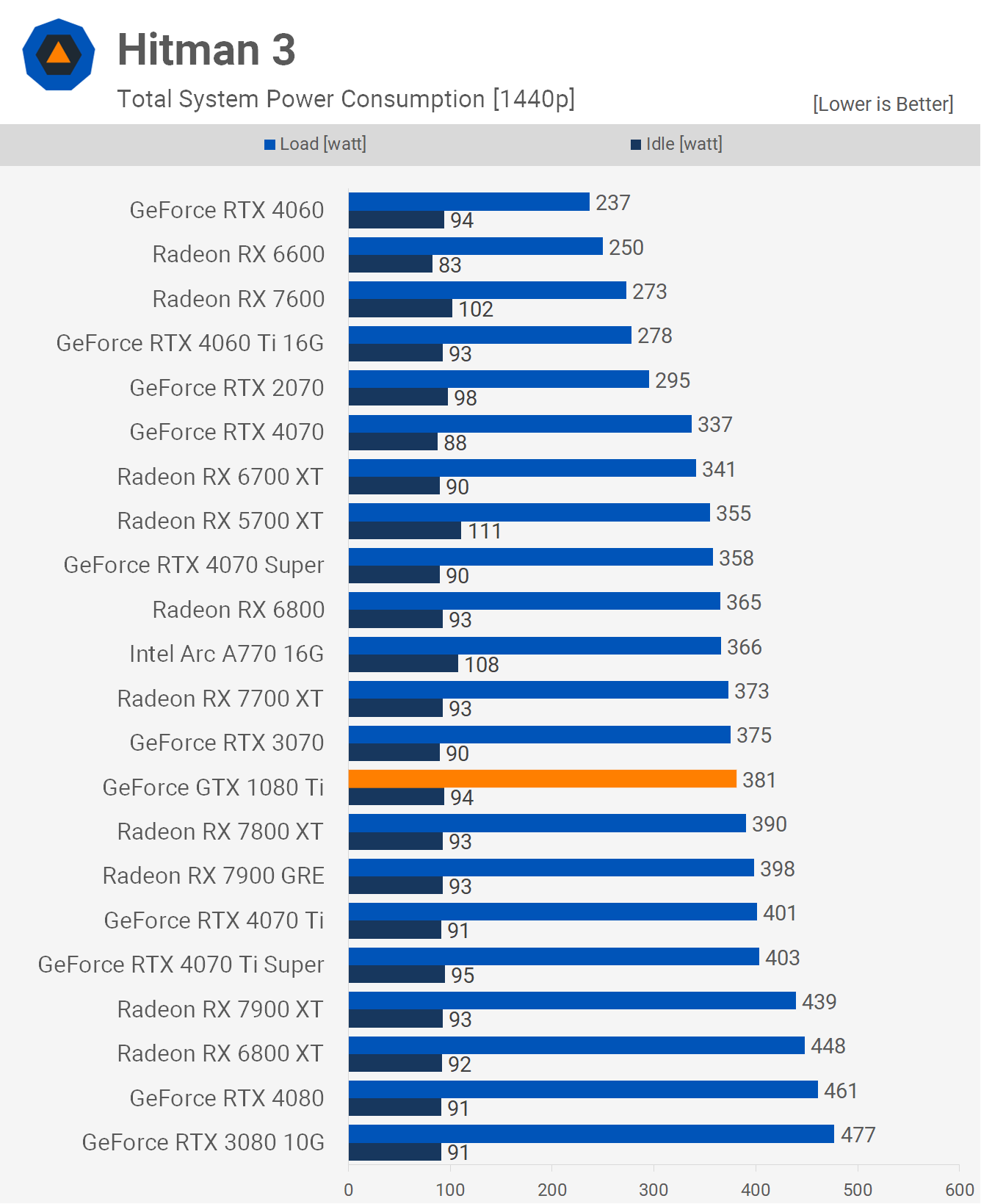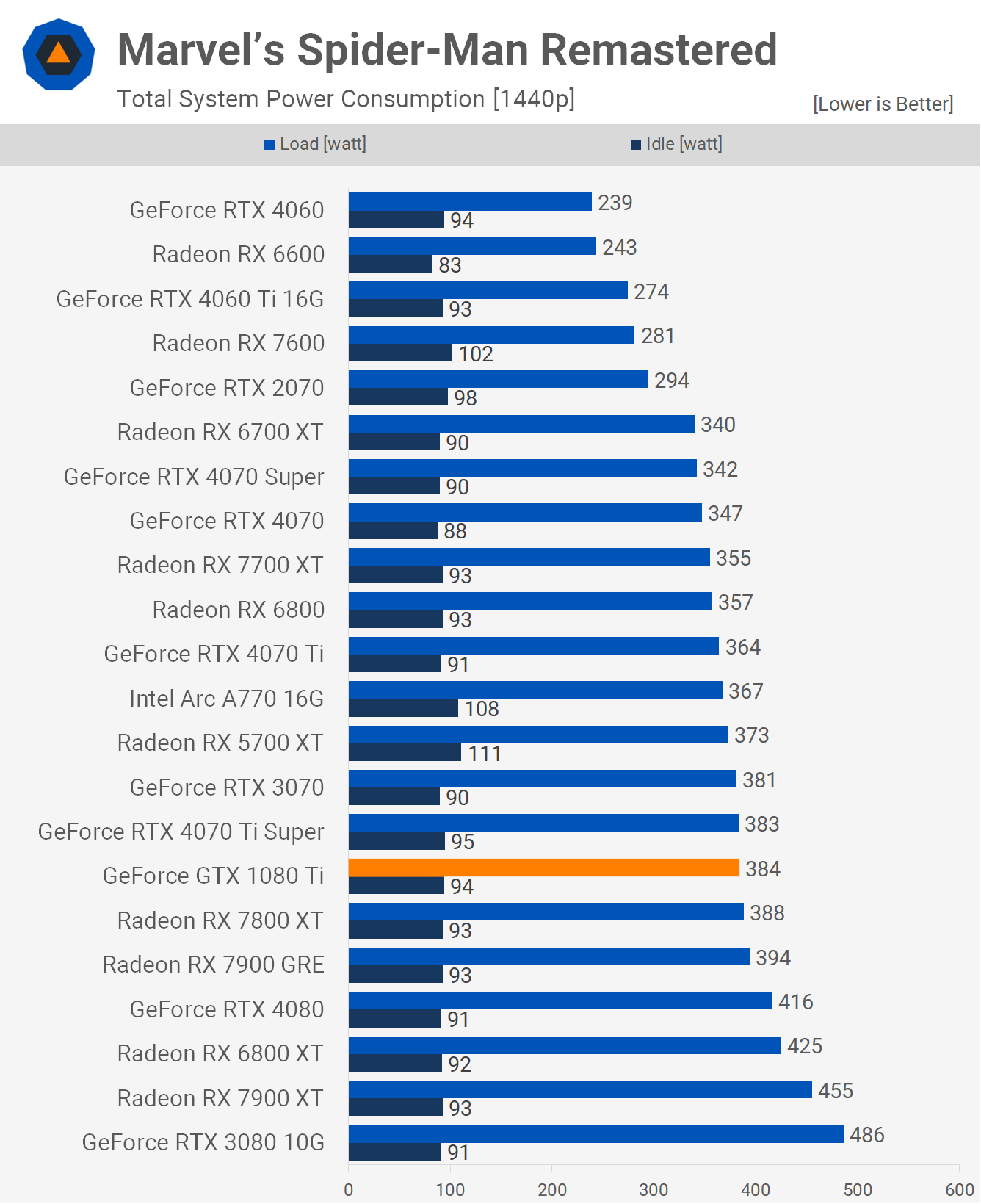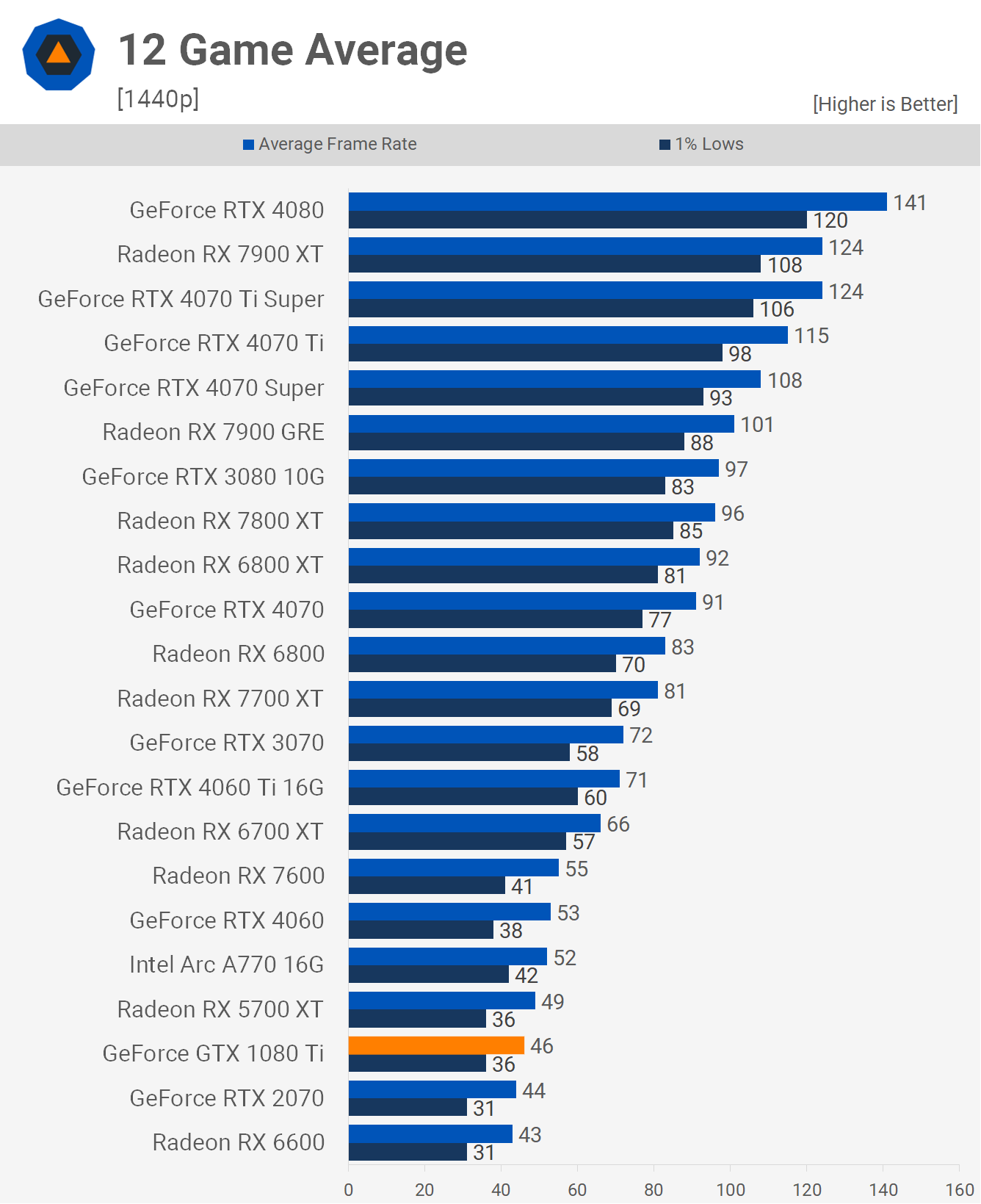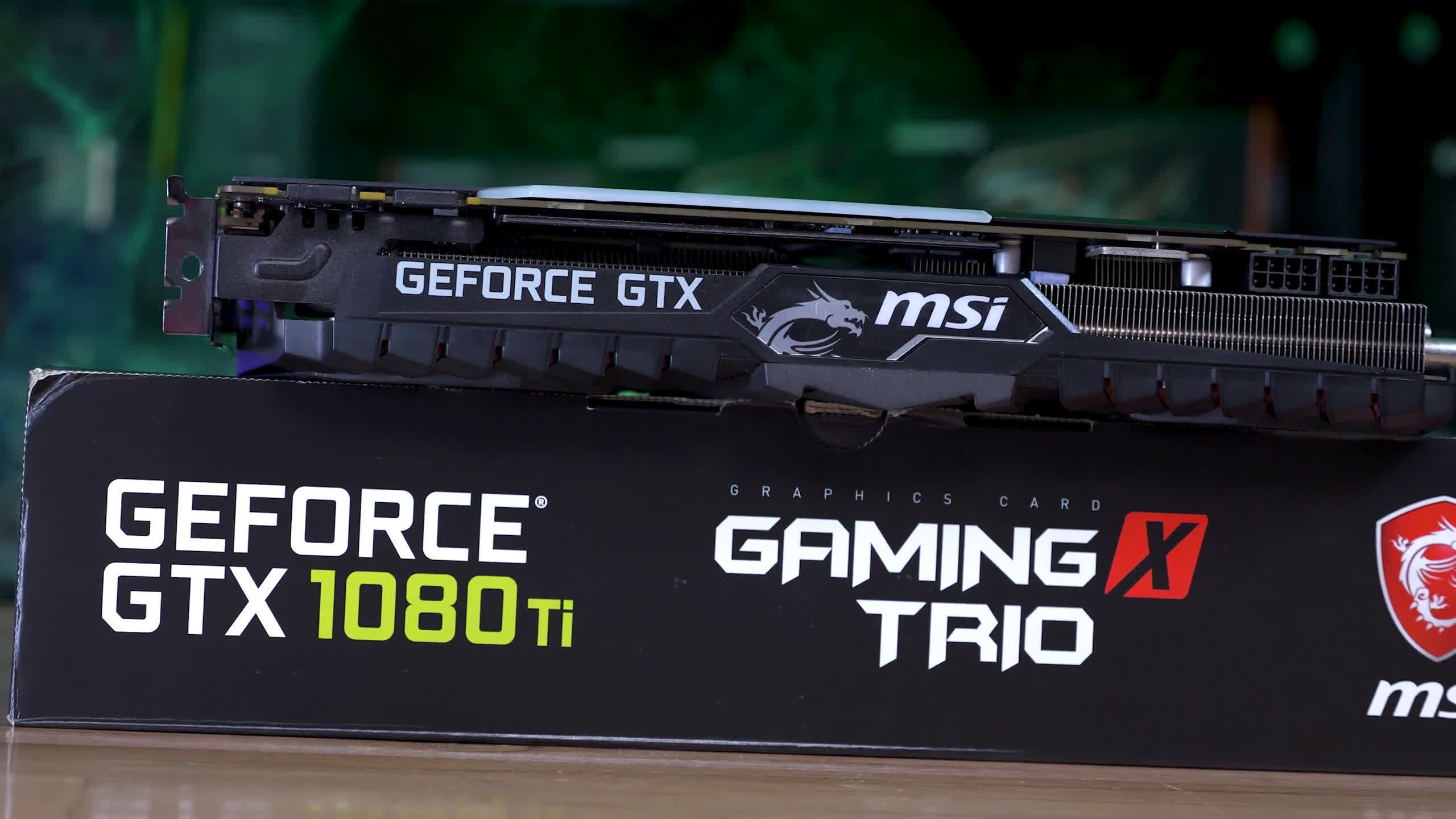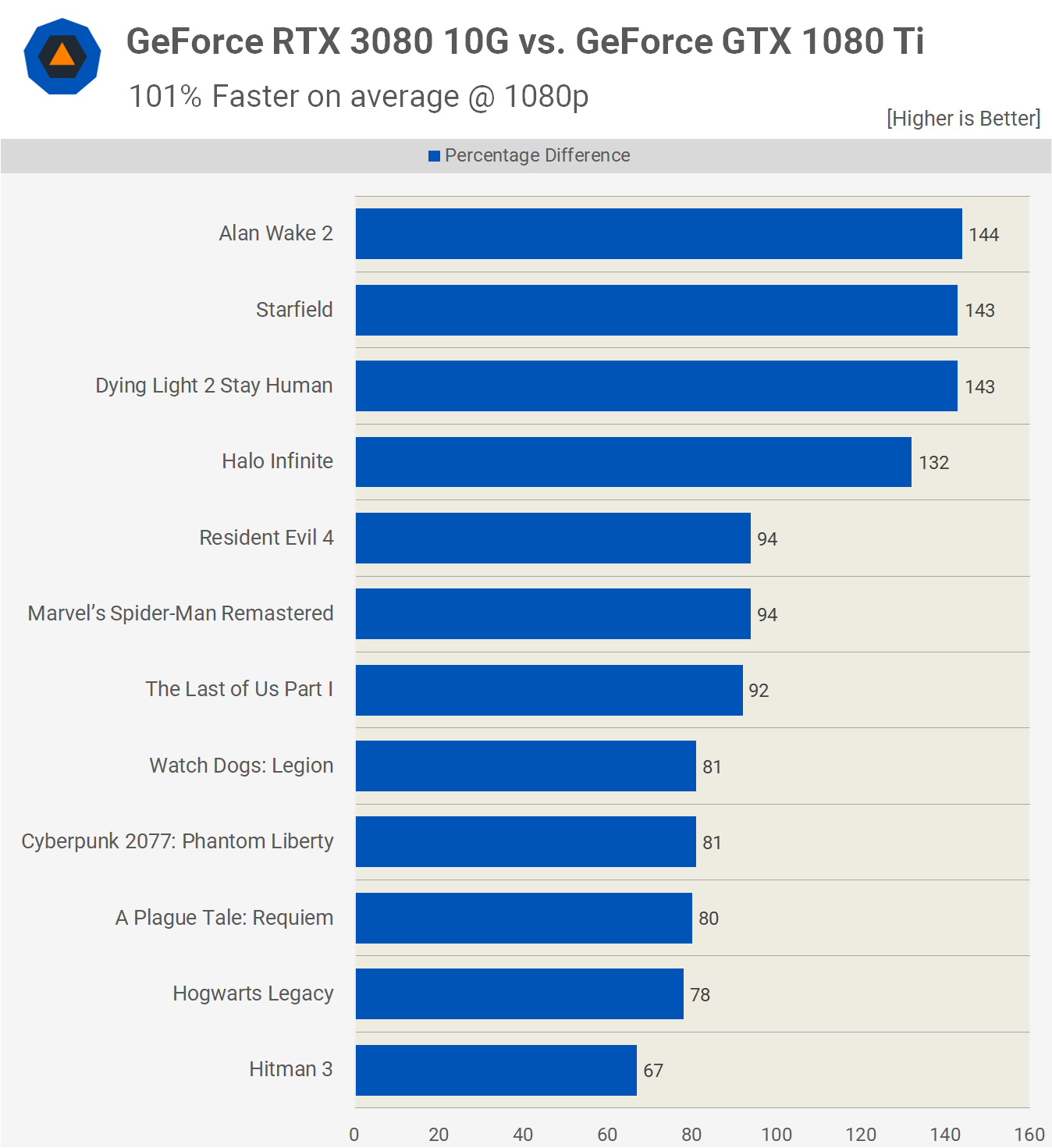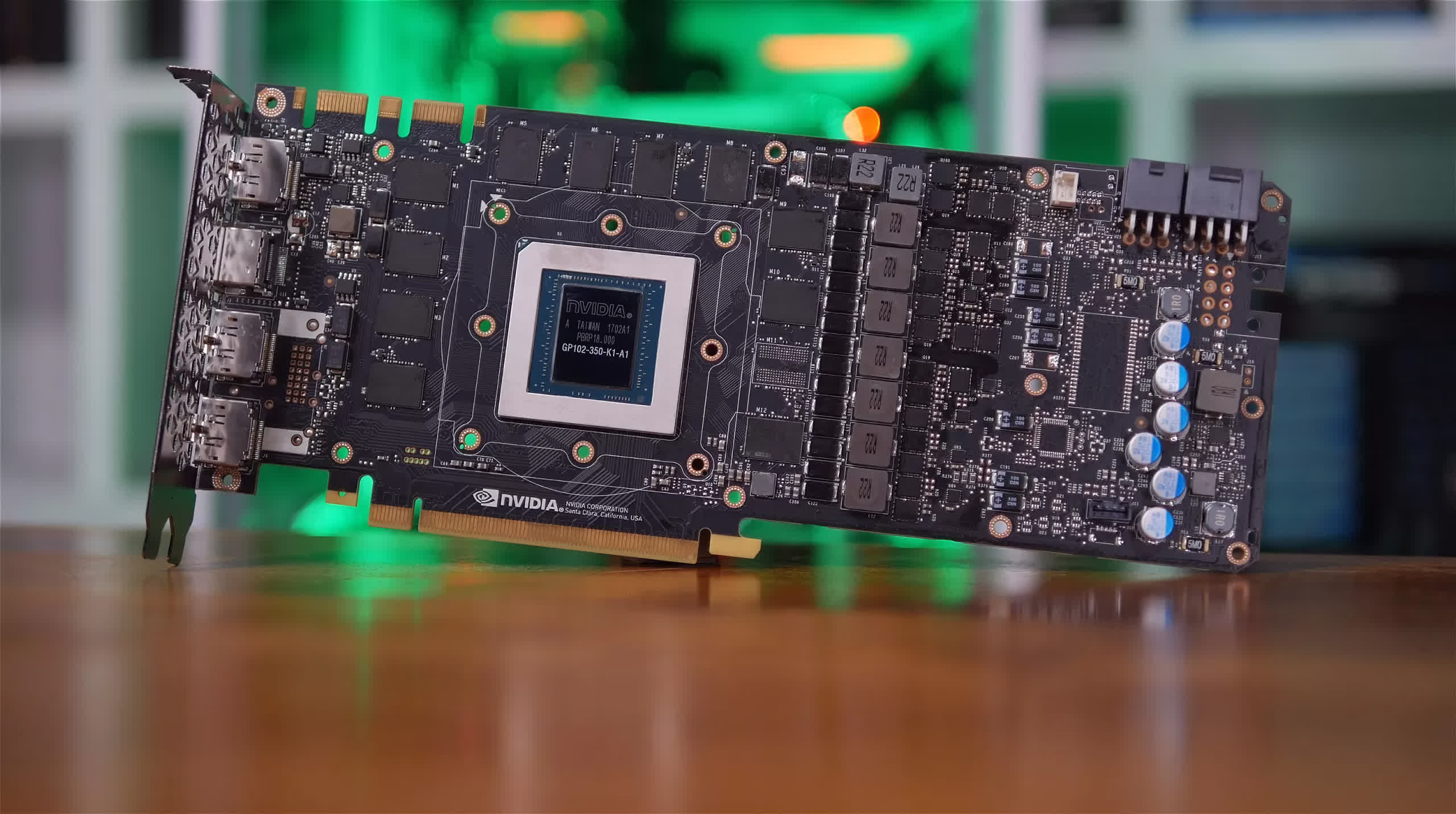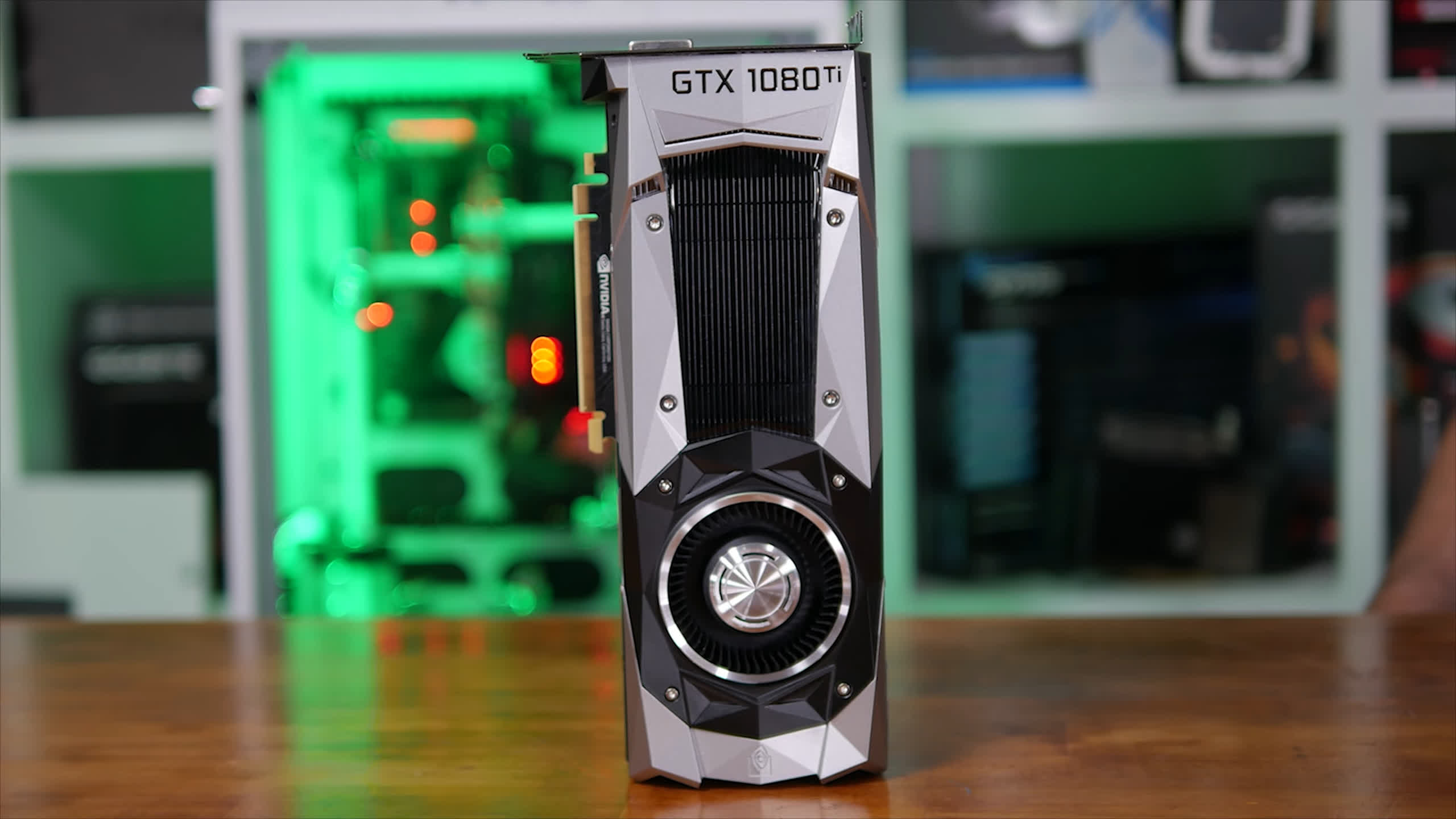The GeForce GTX 1080 Ti is widely regarded as the GOAT for several reasons, even though the 7-year-old GPU lacks ray tracing and DLSS support. First and foremost, its $700 MSRP marks the last time a flagship gaming graphics card was offered at a reasonable price, which significantly contributed to its success. Then couple that fair price with exceptional longevity, and we have the recipe for the best graphics card ever released. So, how is it performing today?
Generally speaking, flagship graphics cards age well in the sense that several years after their release, they are still usable. They may not function as high-end solutions anymore, but they should work well, which is what we found when we last revisited the GTX 1080 Ti in 2022. At the time, it was roughly comparable to a GeForce RTX 3060, a GPU that cost half as much, although the 1080 Ti was four years older.
For today's revisit, we will add the GTX 1080 Ti to our day-one review data to see how it compares to current and previous generation GPUs at 1080p and 1440p across a dozen games. We will also explore some live gameplay in a few new titles such as Helldivers 2, Avatar, Horizon Forbidden West, and Counter-Strike 2.
Our focus will be on 1080p results, but we have also tested at 1440p, and we can discuss the average data towards the end of this review. For testing we're using our Ryzen 7 7800X3D test system with 32GB of DDR5-6000 CL30 memory.
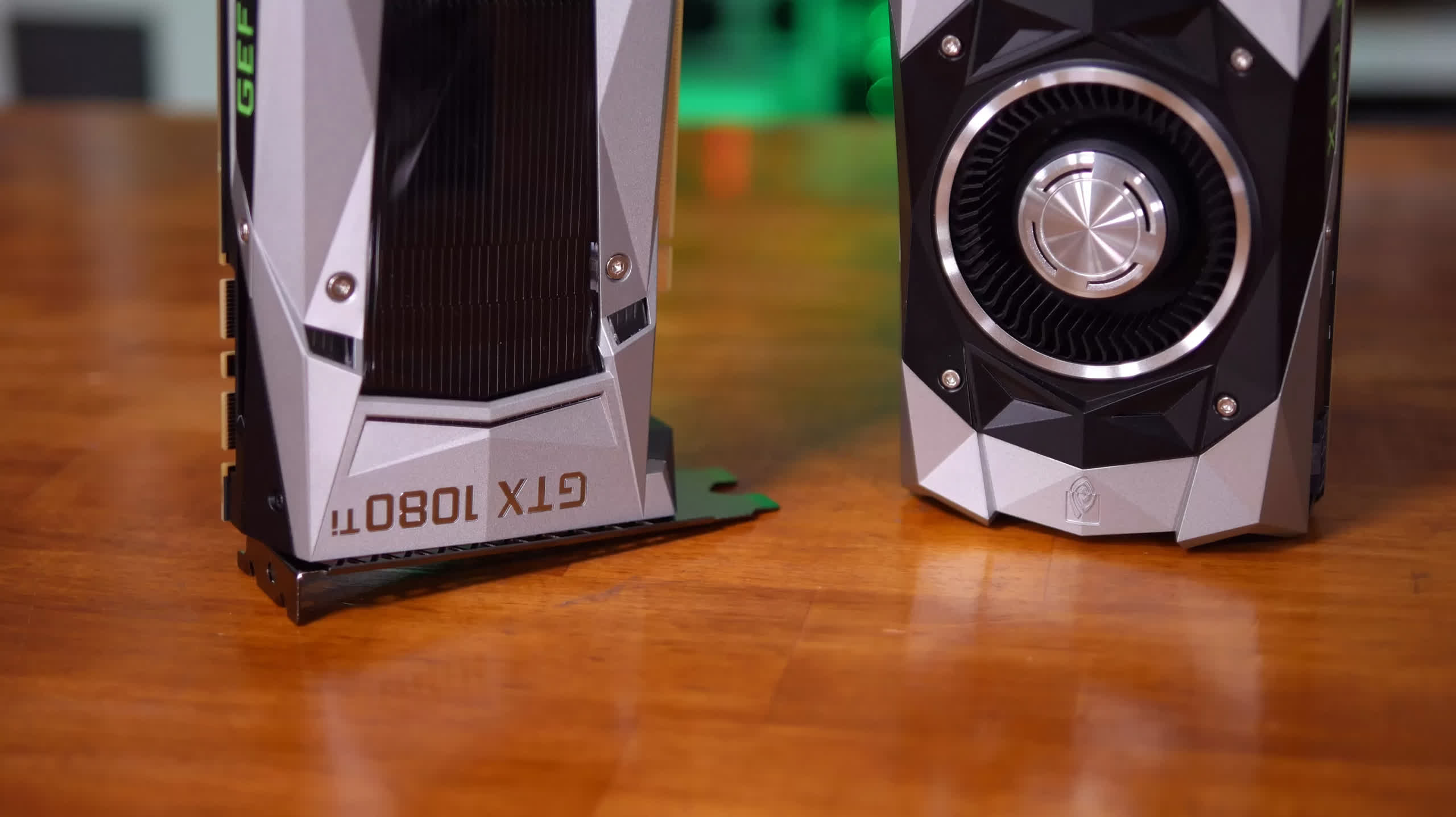
Now, let's get into it…
Benchmarks
Starting with Cyberpunk 2077: Phantom Liberty, we're testing using the high preset, and while it might be just 1080p, the results are still quite impressive as the GTX 1080 Ti matches the performance of the RTX 4060 and RX 7600. That's $300 GeForce performance in this example – not bad after seven years.
In Spider-Man Remastered, the performance is less impressive, but even so, using the highest quality preset, we're still achieving well over 100 fps, comparable to the RTX 2070 and RX 7600.
We were quite surprised to find that 60 fps gaming is a possibility with the GTX 1080 Ti in Hogwarts Legacy using the 'ultra' quality preset. Similar to Cyberpunk 2077, the 1080 Ti matches the RTX 4060 and is roughly on par with the RX 6600 and 7600. A comparison not yet drawn is to the 7900 XT, now available for $700, the original MSRP for the 1080 Ti, offering a 122% performance uplift in this example – significant, yet it is also five and a half years newer.
The GTX 1080 Ti managed to deliver a better experience in The Last of Us Part I compared to the RTX 4060, providing smoother frame time performance thanks to a much larger 11GB VRAM buffer. That said, with just 52 fps on average at 1080p, one would likely need to downgrade the quality settings anyway.
Starfield was a real struggle for the GTX 1080 Ti as it rendered just 28 fps using the ultra quality settings at 1080p. That's comparable performance to the Arc A770, RTX 2070, and RX 6600, surprisingly quite a bit slower than the Radeon RX 5700 XT, and much slower than the RTX 4060.
The last game we'll look at individual results for is Alan Wake 2, where the GTX 1080 Ti also struggles, though not as much as the 5700 XT. It was 28% slower than the RTX 4060, although even the budget GeForce 40 series GPU was very weak here and would benefit from upscaling.
Power Consumption
The GTX 1080 Ti was roughly equivalent to the RX 6600 and RTX 2070 in terms of fps performance in Hitman 3. However, in terms of power usage, looking at total system power, it's comparable to the 7800 XT, which was 90% faster. Compared to the RX 6600, we're seeing just over a 50% increase in total system usage.
Then in Spider-Man, performance was equal to the 5700 XT and RX 7600, while slightly faster than the RTX 2070. Here, total system power usage averaged 384 watts, an almost 40% increase from the RX 7600.
12 Game Average Performance
Across the 12 games tested, the GTX 1080 Ti averaged 64 fps at 1080p, which is similar to the performance of the 5700 XT, A770, RX 6600, and RTX 2070. It was 16% slower than the RTX 4060, so as expected, the GTX 1080 Ti is certainly showing its age. However, the fact that it was able to deliver playable performance in almost all of the games tested while using high to ultra presets is impressive.
The GeForce RTX 4070 Ti was released almost exactly six years after the GTX 1080 Ti, priced at $800, roughly in line with inflation for that period. This suggests that the 4070 Ti is equivalent to the 1080 Ti in terms of pricing. Six years later, you're looking at about a 140% performance increase, which is certainly worth considering for an upgrade, though the improvement is not extraordinary given the time span. Additionally, you're only gaining an extra gigabyte of memory.
For those interested in the 1440p data, here's a quick look: the GTX 1080 Ti rendered an average of 46 fps, placing it alongside the 5700 XT, RTX 2070, and RX 6600, although the Arc A770 pulls slightly ahead here.
Gameplay Footage
In-Game Testing: Avatar
For a better representation of image quality comparisons, check out the HUB video below:

Here's a quick look at performance in Avatar at 1440p using the medium quality preset. For this portion of the testing, we're going to focus on 1440p gaming, using more mid-tier quality settings. As you can see, we're looking at around 50 fps. Not bad, given the age of the graphics card – it's certainly playable and, while not optimal, impressive for a 7-year-old graphics card.
In-Game Testing: Counter-Strike 2
For a better representation of image quality comparisons, check out the HUB video below:

Those who take their Counter-Strike 2 gameplay seriously tell us they prefer 300 fps or more. Fortunately, this is typically what the GTX 1080 Ti can deliver at 1440p using the medium quality preset, and there's certainly room to tune the quality settings. We did see a few instances where frame rates dipped into the low 200s, but we think that for most trying to play this game with a 7-year-old graphics card, that will still be acceptable.
In-Game Testing: Helldivers 2
For a better representation of image quality comparisons, check out the HUB video below:

Helldivers 2 played at around 60 fps using the GTX 1080 Ti at 1440p with medium quality settings, and frame time performance was excellent – certainly enough for some Managed Democracy. We could tell the alien critters were very appreciative, taking a time out to have a nap after being successfully liberated. You're welcome, little guys.
In-Game Testing: Horizon Forbidden West
For a better representation of image quality comparisons, check out the HUB video below:

Moving on to Horizon Forbidden West, again at 1440p using the medium preset, we're looking at around 60 fps, which is certainly enough to play the game and an impressive result given the age of the 1080 Ti. Then if you want a bit more, you can enable FSR 2.2, and we did so using the quality option which boosted performance to around 80 fps, and visually the game still looked great.
In-Game Testing: Ratchet & Clank Rift Apart
For a better representation of image quality comparisons, check out the HUB video below:

Ratchet & Clank Rift Apart was tested at 1440p with the medium preset, and here the GTX 1080 Ti was good enough for between 70-80 fps. Visually, this is a great-looking game, even with the medium quality settings, and with reasonably high frame rates, it was very enjoyable.
In-Game Testing: Star Wars Jedi Survivor
For a better representation of image quality comparisons, check out the HUB video below:

Finally, we took a look at performance in Star Wars Jedi Survivor, which is known to be a very well-optimized title with impeccable frame time performance, and that's how late our April fools' joke is. Of course, none of that is true, but even so, the GTX 1080 Ti is able to play Star Wars Jedi Survivor at around 50 fps using the medium quality settings at 1440p.
Then with the help of 'FSR quality' upscaling, you can boost frame rates to between 70-80 fps, which was a good experience, all things considered.
What We Learned: Still Kicking Along
The venerable GeForce GTX 1080 Ti is still kicking along, though the end is finally in sight with current-generation entry-level GPUs such as the RTX 4060 offering ~20% greater performance on average, albeit admittedly with less VRAM, which is something we hope the next generation of AMD and Nvidia GPUs can address.
As a side note, it's interesting to look back on data from our GeForce RTX 3080 review, which of course included the GTX 1080 Ti. Back then, the RTX 2080 was just 6% faster at 1440p while the RTX 3080 was 58% faster. Although the margin to the 3080 grew to 77% at 4K, the margin to the 2080 shrunk to just 3%.
Unfortunately, we weren't able to include the RTX 2080 in today's review. At some point, we need to limit the number of comparative data points, and just over 20 GPUs seemed reasonable. However, we did include the RTX 3080, and it was interesting to see that in this updated data, using much newer games, the GeForce 30 series GPU was on average 101% faster at 1080p and 111% faster at 1440p.
The games where the 3080 really outperformed the 1080 Ti include Alan Wake 2, Starfield, and then Dying Light 2, along with Halo Infinite. Games where the margins were closer to what we saw in our 3080 review at 4K include Hitman 3, Hogwarts Legacy, A Plague Tale, Cyberpunk, and Watch Dogs: Legion.
As for the RTX 2080, which was previously less than 10% faster than the GTX 1080 Ti, in the list of games tested today it should end up around 20% faster, which is still a weak generational leap, but a big improvement on what we saw in our RTX 3080 review.
This is why the GeForce 20 series was a flop in our opinion; at the time of release, the cost per frame didn't change much, and now many years later, we're seeing around a 20% performance uplift at the $700 price point. This is pretty bad considering the RTX 3080 offers at least twice as much performance. Sure, it's 3.5 years later, but that's still a significant performance uplift.
Also see: The Price is Wrong: This is What GPUs Should Have Cost – Graphics Card Reality Check
It also points to why the GeForce 40 series, like the 20 series, has been underwhelming as the RTX 4070 Ti, accounting for inflation, costs what the GTX 1080 Ti did back in 2017, yet it's just 140% faster on average, which is shy of a 20% increase over the RTX 3080. Meanwhile, the newer RTX 4070 Ti Super is just 24% faster than the RTX 3080, or 28% faster at 1440p. So again, a pretty disappointing generational improvement, more so considering that the Ti Super was released over 3 years later.
Those who purchased a GTX 1080 Ti back in 2017, or shortly after, would have been best off upgrading in late 2020 to an RTX 3070 for roughly the same money. Sadly, though, very few would have been able to do this as the initial demand for the RTX 3080 meant that getting one at the MSRP was nearly impossible, even months after release, at which point the most recent crypto mining boom was in full effect, wiping out the availability of all graphics cards for the next few years.
That's going to do it for this revisit of the GTX 1080 Ti. We suspect there won't be many more revisits for this GPU in the future as we are nearing the end for this one, but what a journey it has been for this legendary GPU.


